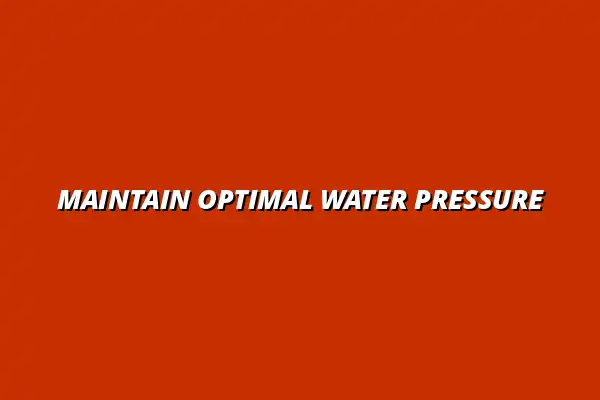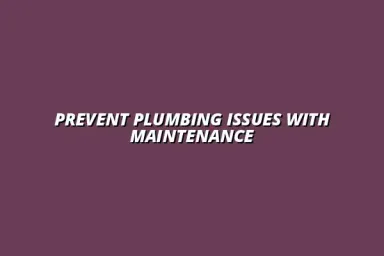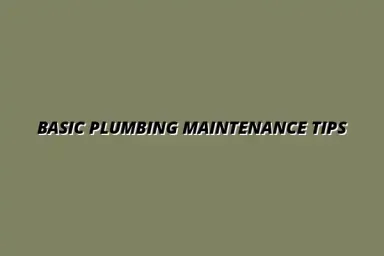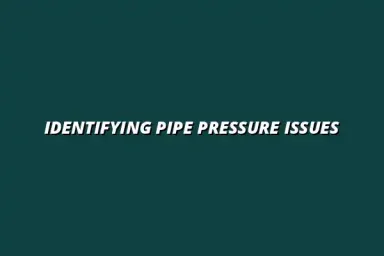Understanding Water Pressure and Its Importance
Water pressure is a vital aspect of any plumbing system. It refers to the force that pushes water through pipes to reach various fixtures in our homes. When we turn on a faucet or flush a toilet, this pressure ensures that water flows smoothly and efficiently, allowing us to complete daily tasks.
Without adequate water pressure, even the simplest activities can become frustrating. Imagine trying to take a shower with a weak stream of water! Understanding water pressure not only helps us appreciate the convenience it brings, but it also highlights its significance in maintaining a functional plumbing system.
Defining Water Pressure in Plumbing Systems
What is Water Pressure?
Water pressure is measured in pounds per square inch (PSI) and is crucial for delivering water from the main supply line to various outlets. When the pressure is too low, you might notice weak flow from your faucets. Conversely, high pressure can lead to leaks or even pipe bursts!
In essence, water pressure acts like the heartbeat of your plumbing system. It's important to monitor and maintain it to ensure that all your plumbing fixtures function correctly. Having a basic understanding of how water pressure works can empower you to address issues before they escalate.
The Role of Water Pressure in Daily Activities
Water pressure plays a significant role in our daily routines. It impacts everything from taking showers to washing dishes and doing laundry. Consistent water pressure ensures that tasks can be completed efficiently without interruptions.
- Showering: A strong water pressure makes for a refreshing shower experience!
- Cooking: Proper pressure allows for quick filling of pots and pans.
- Cleaning: High pressure is vital for rinsing dishes and cleaning surfaces effectively.
Moreover, sufficient water pressure is essential for appliances like dishwashers and washing machines, which rely on it for optimal performance. Ensuring you have the right water pressure can greatly enhance convenience and improve overall quality of life. For example, sudden water pressure drops in the kitchen can be a major inconvenience.
Key Maintenance Tasks for Optimal Water Pressure
Maintaining optimal water pressure involves a few key tasks that can help you avoid plumbing headaches. Regular maintenance ensures your system runs smoothly, providing you with consistent water flow. Here are some essential maintenance tasks to keep in mind:
- Regular Pipe Inspections
- Clearing Blockages and Buildups
- Checking and Replacing Fixtures
- Maintaining Water Valves and Pressure Regulators
- Flushing the System Regularly
- Monitoring Water Pressure Levels
- Engaging a Professional for Comprehensive Maintenance
By following these tasks, you can ensure your plumbing system remains in top shape, helping to maintain strong water pressure throughout your home. For more comprehensive advice, check out this guide on essential plumbing maintenance for homes.
Regular Pipe Inspections
Identifying Signs of Wear and Tear
Regular pipe inspections are crucial for spotting issues early on. Look for visible signs of wear, such as rust, leaks, or bulges in the pipes. Addressing these concerns promptly can prevent bigger problems down the line.
- Discoloration of pipes
- Water stains on walls or ceilings
- Strange noises when water flows
By keeping an eye out for these signs, you can maintain optimal water pressure and ensure a well-functioning plumbing system. Old pipes are a common culprit for water pressure issues.
Tools Needed for Effective Inspections
To effectively inspect your plumbing, you'll need a few essential tools. These can help you identify problems more easily, saving you time and effort.
- Flashlight: Helps you see inside dark spaces.
- Pipe wrench: Useful for tightening or loosening connections.
- Plumber's tape: Ideal for sealing leaks.
Having these tools at hand will make your inspections smoother and more efficient, allowing you to spot and resolve issues faster.
Clearing Blockages and Buildups
Common Causes of Clogs in Pipes
Blockages can significantly affect water pressure in your plumbing system. Understanding the common causes can help you prevent future issues. Here are some frequent culprits:
- Hair and soap buildup in drains
- Food particles in kitchen sinks
- Tree roots invading underground pipes
By recognizing these causes, you can take preventative measures to avoid clogs and maintain optimal water pressure. Regular water pipe cleaning is a great way to prevent clogs.
Methods for Unclogging Pipes Effectively
If you do encounter clogs, knowing how to unclog pipes is essential for restoring water pressure. Here are some effective methods:
- Using a plunger: A simple yet effective tool for minor clogs.
- Applying a drain snake: This tool can reach deeper blockages.
- Using a mixture of baking soda and vinegar: This natural method can dissolve buildup.
By employing these methods, you can keep your pipes flowing freely and maintain strong water pressure throughout your home.
Checking and Replacing Fixtures
How Fixtures Affect Water Pressure
Fixtures, such as faucets and showerheads, can significantly impact water pressure. Over time, mineral buildup can restrict flow, leading to reduced pressure. Regularly checking these fixtures is essential for optimal performance.
- Look for low flow rates when using fixtures.
- Inspect for leaks, which can waste water and affect pressure.
- Consider upgrading to low-flow fixtures that maintain pressure.
By regularly assessing your fixtures, you can ensure they contribute positively to your water pressure. Addressing issues in the bathroom is particularly important.
When to Replace Fixtures for Better Performance
Knowing when to replace fixtures can be tricky! If you notice consistent issues with water pressure, it might be time for an upgrade. Here are some indicators that replacement is necessary:
- Age: Fixtures over ten years old may need replacing.
- Frequent leaks or repairs needed.
- Significant changes in water pressure.
Replacing outdated or malfunctioning fixtures can help restore and even enhance your water pressure, leading to a better experience in your home.
Maintaining Water Valves and Pressure Regulators
Understanding the Function of Pressure Regulators
Pressure regulators play an important role in controlling water pressure throughout your home. They help ensure that pressure remains within a safe range, preventing damage to pipes and fixtures. Understanding their function can aid in maintaining optimal water pressure.
- Regulators adjust high pressure from the main line.
- They help prevent pipe bursts and leaks.
- Regular checks can extend their lifespan.
By monitoring the condition of pressure regulators, you can help maintain consistent water pressure and avoid potential plumbing disasters.
Steps to Check and Adjust Water Valves
Checking and adjusting water valves is a straightforward task that can have a big impact on water pressure. Follow these steps to ensure your valves are functioning properly:
- Locate the main water valve and ensure it's fully open.
- Check for any leaks or signs of damage around the valves.
- Adjust the pressure regulator if water pressure is too high or low.
Maintaining your water valves can greatly influence the overall water pressure in your home.
Flushing the System Regularly
Benefits of Flushing Your Plumbing System
Flushing your plumbing system is essential for keeping water pressure at optimal levels. This process helps remove mineral buildup and sediment that can clog pipes and restrict flow. Some benefits of flushing include:
- Improved water quality and taste.
- Reduced risk of clogs and blockages.
- Enhanced overall plumbing system efficiency.
Regular flushing not only helps maintain water pressure but also contributes to the longevity of your plumbing system.
Best Practices for Flushing Pipes
To effectively flush your pipes, consider these best practices:
- Run cold water for at least 10 minutes to clear out lines.
- Flush toilets to help clear the system.
- Schedule flushing every six months for optimal performance.
By following these steps, you can keep your plumbing system clean and ensure sufficient water pressure in your home.
Monitoring Water Pressure Levels
How to Measure Water Pressure in Your Home
Monitoring water pressure is an important aspect of maintaining a healthy plumbing system. You can easily measure water pressure using a pressure gauge. Here’s how:
- Attach the gauge to an outdoor spigot or faucet.
- Turn on the faucet completely.
- Read the measurement displayed on the gauge.
This simple process helps you keep tabs on your water pressure, allowing you to identify potential issues before they escalate.
Optimal Water Pressure Ranges for Household Use
Knowing the optimal water pressure range for your home can help you ensure everything functions properly. Ideally, household water pressure should be between 40 and 60 PSI. Here’s how different ranges affect your plumbing:
- Below 40 PSI: You may experience weak flow and pressure issues.
- Between 40-60 PSI: Ideal for most households.
- Above 60 PSI: Can lead to leaks and damage over time.
By monitoring your water pressure and keeping it within this range, you can avoid plumbing problems and ensure efficient water flow.
Engaging a Professional for Comprehensive Maintenance
When to Call a Plumber for Help
While many maintenance tasks can be done at home, sometimes it’s best to call in a professional. If you notice persistent issues with water pressure, such as frequent fluctuations or unexplained drops, it might be time to seek expert help. Additionally, consider calling a plumber if:
- You spot large leaks or flooding.
- Your fixtures are consistently malfunctioning.
- You're unsure about performing repairs yourself.
Engaging a professional can save you time and help avoid costly mistakes! For reliable plumbing services in Great Barr, Birmingham, consider checking out this local plumber.
Benefits of Professional Inspections and Repairs
Hiring a professional plumber comes with several advantages. Experts can identify underlying issues that you might miss and provide effective solutions. Some benefits of professional plumbing services include:
- Thorough inspections to catch hidden problems.
- Access to specialized tools and knowledge.
- Guaranteed work and warranties on repairs.
Investing in professional plumbing services can ultimately save you money and ensure your water pressure remains optimal for years to come.
Addressing Common Concerns and Questions
How Does Water Quality Affect Water Pressure?
Water quality plays a significant role in determining the efficiency of your plumbing system. When the water is hard, it contains a high level of minerals like calcium and magnesium. These minerals can build up inside pipes, which can lead to reduced water flow and lower overall water pressure.
Additionally, hard water can cause sediment to accumulate in fixtures and appliances, further impacting their ability to function properly. If you notice a consistent drop in water pressure, it might be time to check the water quality and the state of your plumbing system. Low water pressure in your water heater can be a particular problem.
- Hard Water Effects: Reduced flow through pipes.
- Clogged Fixtures: Mineral buildup in faucets and showerheads.
- Affect on Appliances: Poor performance of dishwashers and washing machines.
Impact of Hard Water on Plumbing Systems
Hard water can lead to scaling, which is a hard, chalky buildup that forms inside pipes over time. This scaling can restrict water flow, making it difficult for systems to maintain optimal pressure. If left unchecked, it could ultimately lead to pipe damage and costly repairs.
Moreover, appliances that rely on water can suffer from reduced efficiency. This means they may use more energy and take longer to perform their tasks. Addressing hard water issues can save you money in the long run and improve your home’s water pressure!
Solutions for Improving Water Quality
Improving your water quality is vital for maintaining good water pressure. Here are several solutions to consider:
- Water Softeners: Install a system to reduce hardness in water.
- Regular Cleaning: Flush out sediment from pipes and fixtures.
- Inline Filters: Use filters to remove impurities before they reach your plumbing.
Implementing these solutions can greatly enhance water quality and support better water pressure in your home.
What Are the Signs of Low Water Pressure?
Recognizing the signs of low water pressure early can save you from more serious plumbing issues later. Common symptoms include weak water flow from faucets, slow filling toilets, and showers that lack sufficient pressure. These signs can indicate underlying problems that need attention.
Another telltale sign is if one fixture has low pressure while others function normally. This could suggest blockages or issues localized to that specific fixture or pipe.
- Weak Faucet Flow: Noticeable reduction in water flow.
- Slow Filling Toilets: Takes longer than usual to fill the tank.
- Shower Pressure Issues: A weak stream while showering.
Common Symptoms Indicating Low Pressure Issues
Besides the signs mentioned, you might also notice fluctuating water pressure, especially during peak usage times. If water pressure decreases when multiple fixtures are in use, this could indicate your system is struggling to maintain flow. Additionally, strange noises like banging or vibrating pipes can also signal problems.
These symptoms highlight the importance of regular maintenance and monitoring to catch any issues before they escalate!
Steps to Take When Experiencing Low Water Pressure
If you find yourself facing low water pressure, here are some steps to take:
- Check for Clogs: Inspect fixtures and pipes for blockages.
- Test Pressure Regulator: Ensure the pressure regulator is functioning correctly.
- Look for Leaks: Examine your plumbing for signs of leaks that could be affecting pressure.
Taking these steps can help identify the cause of low pressure and lead you toward a solution.
Maintaining Good Water Pressure: A Summary of Best Practices
Recap of Essential Maintenance Tasks
Maintaining good water pressure requires consistent attention to various plumbing tasks. Regular pipe inspections, clearing clogs, and checking fixtures are all crucial steps. Each of these tasks plays a vital role in keeping your plumbing system functioning optimally.
It's also important to monitor water quality and make adjustments as needed. This proactive approach helps in preventing pressure issues before they arise.
Importance of Consistent Maintenance and Monitoring
Consistency is key when it comes to plumbing maintenance. By establishing a routine, you'll be better equipped to spot potential issues early. Regular monitoring not only helps maintain good water pressure but also prolongs the lifespan of your plumbing system. Trust me, it’s worth the effort!
Encouraging Proactive Plumbing Care
As homeowners, we have a role to play in maintaining our plumbing systems. Adopting proactive plumbing care can significantly impact water pressure and overall functionality. This includes keeping an eye on water quality, conducting regular inspections, and addressing issues promptly.
Additionally, sharing knowledge about plumbing maintenance can benefit our communities. By encouraging others to be proactive, we all can enjoy the comforts of good water pressure!
Tips for Homeowners to Sustain Water Pressure
Here are some practical tips for homeowners to maintain water pressure:
- Keep a Maintenance Schedule: Set reminders for regular checks.
- Use Quality Fixtures: Invest in good-quality faucets and appliances.
- Educate Yourself: Familiarize yourself with basic plumbing knowledge.
Following these tips will help ensure your home enjoys consistent and reliable water pressure.
Resources for Further Learning on Plumbing Maintenance
For those interested in deepening their understanding of plumbing maintenance, there are plenty of resources available:
- Online Tutorials: Websites like YouTube have instructional videos.
- Books: Look for plumbing maintenance books at your local library.
- Local Workshops: Check community centers for classes on home maintenance.
Utilizing these resources can empower you to take better care of your plumbing system and maintain optimal water pressure!

 Kiran Almasi
Kiran Almasi

